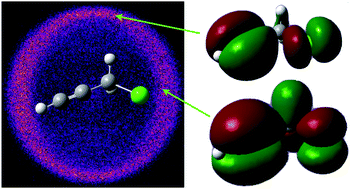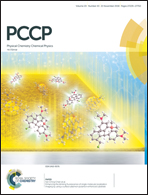Mixed transitions in the UV photodissociation of propargyl chloride revealed by slice imaging and multireference ab initio calculations†
Abstract
Resonance-enhanced multiphoton ionization (REMPI) and DC slice imaging were used to detect photoproducts Cl (2P3/2), spin–orbit excited Cl* (2P1/2), and C3H3 in the photodissociation of propargyl chloride at 212 and 236 nm. Cl and Cl* translational energy distributions peak at high recoil energy, suggesting impulsive energy release in the C–Cl coordinate. Near 236 nm, photofragment angular distributions show rapidly changing anisotropy across the main peak for both Cl and Cl*, indicating excitations arising from in-plane or out-of-plane π systems. At 212 nm, the distribution is broader and isotropic for both Cl products. Ionization of C3H3 at 212 nm via 1 + 1 REMPI provides additional insight into these processes. A portion of the C3H3+ distribution is momentum-matched to the Cl, but in addition, there is a component assigned to cyclic C3H3+ formed from dissociative ionization of propargyl chloride. Multireference ab initio calculations show that excitations to three triplet states contribute at the long wavelength region, while predissociation from the first excited singlet state plays a role at the shorter wavelength.



 Please wait while we load your content...
Please wait while we load your content...